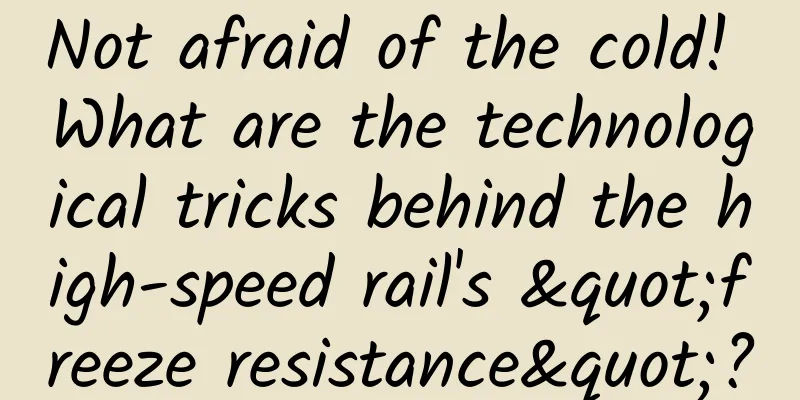Not afraid of the cold! What are the technological tricks behind the high-speed rail's "freeze resistance"?

|
At the beginning of February, widespread rain, snow and freezing weather in the central and eastern regions of China combined with the Spring Festival travel rush, which brought considerable obstacles to passengers' travel home. In an emergency, the China Railway Corporation activated the emergency plan and dispatched a large number of spare diesel locomotives to start disaster relief and rescue. Stranded passengers were gradually evacuated, and videos of green locomotives pulling silver-white high-speed trains frequently became popular searches on the Internet. Many netizens lamented: "We still have to look to our elderly father at critical moments!" Many people are also curious: Why can ordinary trains run smoothly in freezing rain? Today we will specifically popularize the above questions and introduce to readers the effective measures taken by high-speed rail in the face of extreme weather such as freezing rain. 01 Why did freezing rain cause many high-speed trains to stop running? Freezing rain, a kind of "ground-piercing rain" that resembles rain, snow and ice, is rare in many areas outside northern my country. However, due to the southward movement of cold weather in recent years, freezing rain has also appeared frequently in winter in many provinces in North China, South China, and Southwest China, bringing serious impacts on communications, electricity, and transportation, and easily causing national economic losses. For railways, especially high-speed railways, the hazards of freezing rain are mainly concentrated on the following equipment: rails, turnouts, contact networks, and EMUs . Ice on rails can cause vehicles to slip, greatly affecting traction; ice on turnouts can freeze the active frogs, hindering the opening and closing of turnouts, posing safety hazards; ice on the EMU body can increase the running resistance of the vehicle; the most serious is ice on the contact network, which can cause accidents such as overload breakage, ice flash, and obstruction of current acquisition. Image source: Internet When the ice thickness of the overhead contact network exceeds its ice coverage limit, problems such as wire breakage, fracture and deformation of pillars or supporting devices may occur, resulting in large-scale train suspension; When the overhead wire is covered with ice, some conductive particles will be frozen on the surface of the insulator string. When the ice melts, the conductivity of the surface of the insulator string will increase significantly, which is very likely to cause "ice flash" accidents, resulting in frequent line tripping and carbonization damage of the insulator string. When the contact wire is covered with ice, there will be a layer of ice between the contact plate and the contact wire, which cannot make direct contact, resulting in an arc that burns the pantograph plate and the contact wire. In addition, ice nodules and icicles are foreign objects to the contact network, which not only affect the mechanical and electrical properties of the contact network, but may also cause power supply failures or bow-net failures, resulting in tripping and power outages. Because of this, high-speed trains that can run in heavy snow and strong winds are likely to be blocked once they encounter freezing rain. It is not that the railway department does not want to run high-speed trains in such weather, but once forced to run, it will bring greater risks. 02 The green train is "standing up": Why are ordinary trains not afraid of freezing rain? When a high-speed train broke down, the old green train was ordered to pull the high-speed train. Is the high-speed train too delicate? No! How can a high-speed train that can run at a speed of 350km/h be delicate? Is the ordinary train more "tough"? No! The fundamental reason why the green train is called the "emergency diesel hot standby locomotive" of the railway department is still the two factors of "train speed" and "traction method". Dongfeng 4 diesel locomotive. Copyright image. Reproduction may cause copyright disputes. Let's talk about "traction method" first. There are currently two common traction methods for railway trains: internal combustion and electric. Steam locomotives were completely eliminated in 2005 and do not count. Locomotives that burn diesel are internal combustion locomotives, and those powered by overhead wire are electric locomotives. There are fewer and fewer ordinary passenger trains that use internal combustion in China, because by 2022, the railway electrification rate in our country has reached 73.8%, so whether it is high-speed rail or ordinary passenger trains, most of them use electric traction . Electric traction is good, but it is easily affected by extreme weather such as freezing rain. Although diesel locomotives are not very friendly to the environment and their traction capacity is slightly inferior, they can show their strengths in extremely bad weather. This is one of the reasons why diesel locomotives were used to pull high-speed rail rescue in the freezing rain weather in the south. Another factor, "train speed", is easy to understand. The rails are so slippery that trains dare not go fast. On the contrary, ordinary trains with slow speeds can adapt to this environment. The slower the train speed, the higher the safety factor in bad weather . 03How does the high-speed rail system resolve the freezing rain crisis? In Northeast China and Inner Mongolia where rain and snow are common, the railway department has to deal with adverse rain and snow weather every year to ensure the safe operation of trains. Accordingly, it has formed a set of "magic weapons" to defeat the enemy, turning the seemingly troublesome freezing rain into a beautiful landscape along the railway. Anti-icing and de-icing of contact network - There are two countermeasures for railway power contact network to deal with freezing rain disasters: one is anti-icing, and the other is de-icing. Anti-icing is to prevent disasters before they happen, and de-icing is a passive response. Anti-icing measures can be taken by applying anti-icing coatings such as electrothermal, photothermal, ice-melting and hydrophobic on the contact wires, which are called "electrothermal anti-icing coatings". After adding conductive fillers, leakage current will flow inside the semi-conductive coating, thereby generating Joule heat, field effect heat, etc., which makes the coating heat up and maintain a certain temperature, achieving the effect of anti-icing. Workers in the power supply section carried out de-icing operations on the railway contact network equipment during the window period. Image source: Xinhua News Agency Another anti-icing measure is the "current thermal online anti-icing technology". In layman's terms, as long as there are trains running, there must be current in the contact network, and the current generates heat energy, which can prevent the wires from icing. However, this method also has obvious disadvantages. If the number of trains running is too small, the current in the wires will be intermittent, and the anti-icing effect will be poor. There is also a device called "Category Catenary Ice Early Warning Monitoring" device, which can collect terrain data, climate data, and ice data for areas where the catenary is prone to ice. It uses meteorological satellites and ground stations, relies on supercomputing centers, forms grids based on different resolutions and accuracies on the display screen, realizes grid-based micro-topography area catenary ice process monitoring, and automatically inverts the affected line sections. It is also an active prevention measure. As for de-icing the contact network, there are many ways. For example, the most direct way is to send people to knock the ice by hand. More advanced means can use robots to de-ice, wind energy to de-ice, chemical agents to melt ice, microwaves, laser equipment to de-ice, etc. EMU deicing - EMUs are precision equipment, and long-term manual deicing is definitely not suitable, so the development of intelligent deicing equipment is a natural thing. For example, the HTK-CBXO high-cold high-speed rail ice and snow melting device independently designed and developed by Harbin Railway Bureau Group Co., Ltd. only requires 2 people to operate and can complete the deicing of 8 EMUs in 1 hour. In the past, the same workload required 16 people and 4 hours, which greatly improved the deicing efficiency of EMUs. Turnout deicing - Turnouts are one of the key equipment in the track system and are responsible for the train changing tracks. In the cold northern regions, China's turnout deicing and snow melting are mainly done by electric heating. For example, the RD1 electric heating turnout deicing system has been widely used in the railway system. The main working principle of this device is to heat up the turnout by electric heating to melt snow and deicing. This type of turnout deicing device has a decent working efficiency, but it is a veritable "electric tiger". It consumes a lot of electricity during operation, and the cost is high. It can no longer meet the needs of the high-speed development of modern railways. Train staff use a blowtorch to de-ice the switch. Image source: Xinhuanet In recent years, railway scientists have developed an intelligent snow-melting system based on meteorological information and train scheduling. The system can be started and stopped automatically using the meteorological station, and the corresponding turnout action opening sequence table in the station can be queried according to the train operation plan data, and the turnouts on the approaching road can be heated and snow-melted in advance, thereby changing the existing system's manual start and control mode of heating all turnouts in the station after start, and realizing the system's automatic start and stop and energy saving and consumption reduction. I believe that with the continuous advancement of engineering materials and information technology, the railway department will develop more efficient and energy-saving de-icing equipment to ensure the safe operation of high-speed railways. The end of the year is approaching, and I hope that everyone who goes home for the New Year can arrive safely. Author: Wang Lin, senior railway engineer, member of the Chinese Writers Association, member of the Chinese Science Writers Association, director of the Tianjin Science Writers Association Reviewer: Zhao Hongyu, Electrification Expert of China Railway Design Group Produced by: Science Popularization China Produced by: China Science and Technology Press Co., Ltd., China Science and Technology Publishing House (Beijing) Digital Media Co., Ltd. |
>>: The poet depicts the beauty of ice and snow, and also records the "darkness" of ice and snow.
Recommend
A short-sighted geek buys breakfast and can "calculate" the price without even looking at the price list! ?
Many students feel confused and painful when they...
up to date! Reference data of 39 information flow platforms!!
The November data of major information flow platf...
How to deal with the sluggish growth of TikTok accounts?
User visual fatigue, slow content iteration, and ...
How does Xiaohongshu do social e-commerce? Weibo + Tmall?
Last year, a top French jewelry brand conducted a...
Please save these tips for achieving mobile app user growth!
When traffic and users in various industries are ...
Three Elements of a Truly Intelligent Robot
I finally took some time out yesterday to finish ...
Six warnings including high temperature, heavy rain and severe convection are issued at the same time. Pay attention to these places! Please take precautions
Weekend rest and travel Most afraid of changeable...
Use of Android performance analysis tools
1. Android Studio-Memory Monitor How to use Run y...
A must-read for mid to high-level operators! How to build a product operation system based on business logic?
Special reminder: This article is a long logical ...
Lao Wang from the west of the village: A training camp to teach you how to make lessons (completed) worth 799 yuan
The course is divided into 5 chapters (the underl...
Qingmu·WX group project·earn millions a year (updating) Resource acquisition
Qingmu, the founder of Weiqunhui, has been workin...
In 3 minutes, you can learn about all advertising resources in iQiyi’s information flow!
The latest data from iResearch MUT in April shows...
New research: Birds' running style is so "cunning"
Author: Duan Yuechu and Huang Yanhong According t...
Agora.io launches AMG Voice, a real-time voice service for mobile games
On March 9, Agora.io released AMG Voice (Agora Mo...






![Luo Yao's Graphic Design Thinking Course ended in March 2020 [HD video only]](/upload/images/67cbfd8b409f6.webp)


